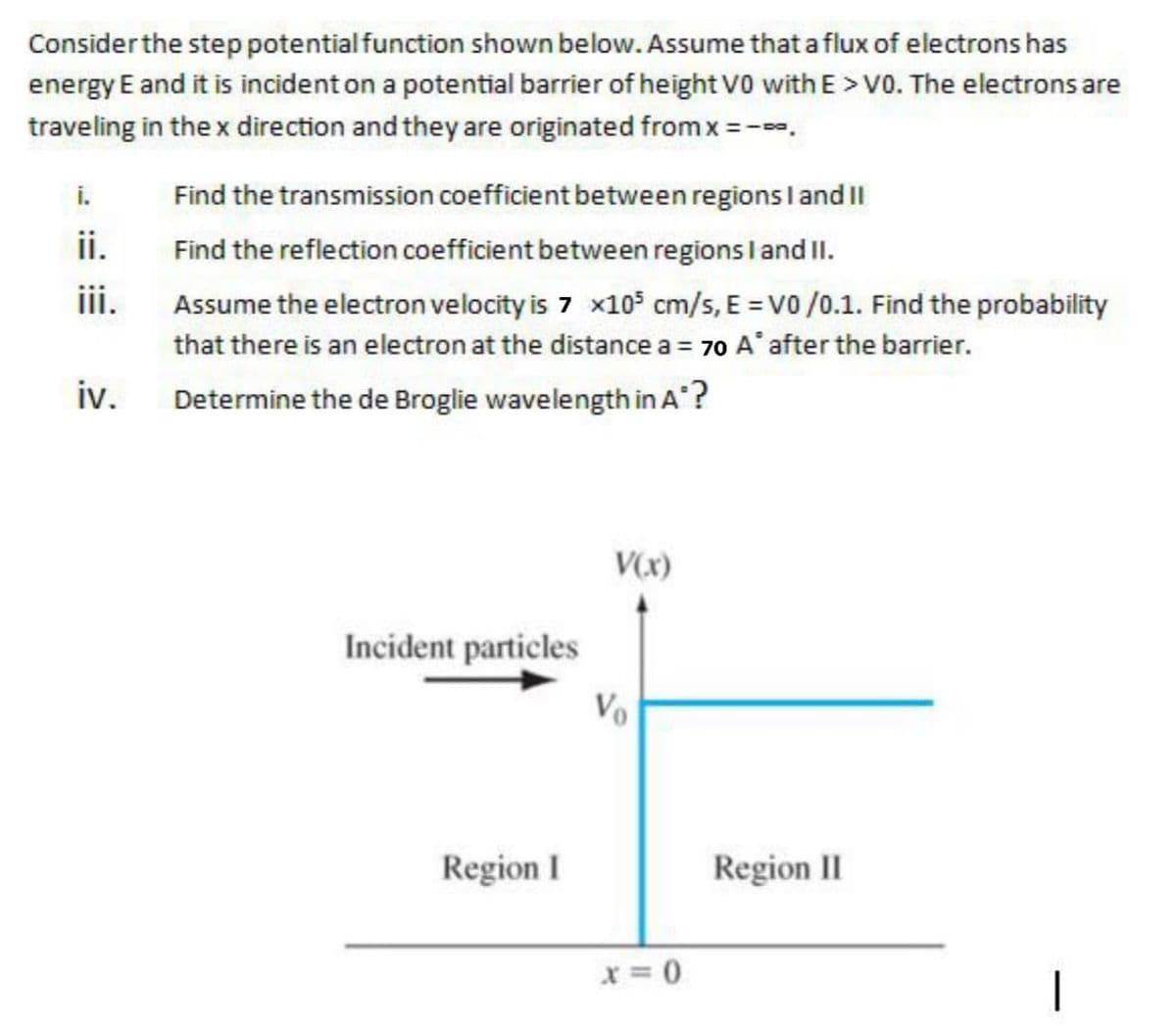Consider the step potential function shown below. Assume that a flux of electrons has energy E and it is incident on a potential barrier of height Vo with E > V0. The electrons are traveling in the x direction and they are originated from x =--. i. Find the transmission coefficient between regions l and II i. Find the reflection coefficient between regionsland II. ii. Assume the electron velocity is 7 x105 cm/s, E = V0 /0.1. Find the probability that there is an electron at the distance a = 70 A' after the barrier. iv. Determine the de Broglie wavelength in A? V(x) Incident particles Vo Region I Region II x = 0
Consider the step potential function shown below. Assume that a flux of electrons has energy E and it is incident on a potential barrier of height Vo with E > V0. The electrons are traveling in the x direction and they are originated from x =--. i. Find the transmission coefficient between regions l and II i. Find the reflection coefficient between regionsland II. ii. Assume the electron velocity is 7 x105 cm/s, E = V0 /0.1. Find the probability that there is an electron at the distance a = 70 A' after the barrier. iv. Determine the de Broglie wavelength in A? V(x) Incident particles Vo Region I Region II x = 0
Introductory Circuit Analysis (13th Edition)
13th Edition
ISBN:9780133923605
Author:Robert L. Boylestad
Publisher:Robert L. Boylestad
Chapter1: Introduction
Section: Chapter Questions
Problem 1P: Visit your local library (at school or home) and describe the extent to which it provides literature...
Related questions
Question

Transcribed Image Text:Consider the step potential function shown below. Assume that a flux of electrons has
energy E and it is incident on a potential barrier of height V0 with E > V0. The electrons are
traveling in the x direction and they are originated from x = --,
i.
Find the transmission coefficient between regions l and II
ii.
Find the reflection coefficient between regions l and II.
ii.
Assume the electron velocity is 7 x105 cm/s, E = V0 /0.1. Find the probability
that there is an electron at the distance a = 70 A* after the barrier.
iv.
Determine the de Broglie wavelength in A?
V(x)
Incident particles
Region I
Region II
x = 0
Expert Solution
This question has been solved!
Explore an expertly crafted, step-by-step solution for a thorough understanding of key concepts.
This is a popular solution!
Trending now
This is a popular solution!
Step by step
Solved in 2 steps with 2 images

Knowledge Booster
Learn more about
Need a deep-dive on the concept behind this application? Look no further. Learn more about this topic, electrical-engineering and related others by exploring similar questions and additional content below.Recommended textbooks for you

Introductory Circuit Analysis (13th Edition)
Electrical Engineering
ISBN:
9780133923605
Author:
Robert L. Boylestad
Publisher:
PEARSON

Delmar's Standard Textbook Of Electricity
Electrical Engineering
ISBN:
9781337900348
Author:
Stephen L. Herman
Publisher:
Cengage Learning

Programmable Logic Controllers
Electrical Engineering
ISBN:
9780073373843
Author:
Frank D. Petruzella
Publisher:
McGraw-Hill Education

Introductory Circuit Analysis (13th Edition)
Electrical Engineering
ISBN:
9780133923605
Author:
Robert L. Boylestad
Publisher:
PEARSON

Delmar's Standard Textbook Of Electricity
Electrical Engineering
ISBN:
9781337900348
Author:
Stephen L. Herman
Publisher:
Cengage Learning

Programmable Logic Controllers
Electrical Engineering
ISBN:
9780073373843
Author:
Frank D. Petruzella
Publisher:
McGraw-Hill Education

Fundamentals of Electric Circuits
Electrical Engineering
ISBN:
9780078028229
Author:
Charles K Alexander, Matthew Sadiku
Publisher:
McGraw-Hill Education

Electric Circuits. (11th Edition)
Electrical Engineering
ISBN:
9780134746968
Author:
James W. Nilsson, Susan Riedel
Publisher:
PEARSON

Engineering Electromagnetics
Electrical Engineering
ISBN:
9780078028151
Author:
Hayt, William H. (william Hart), Jr, BUCK, John A.
Publisher:
Mcgraw-hill Education,